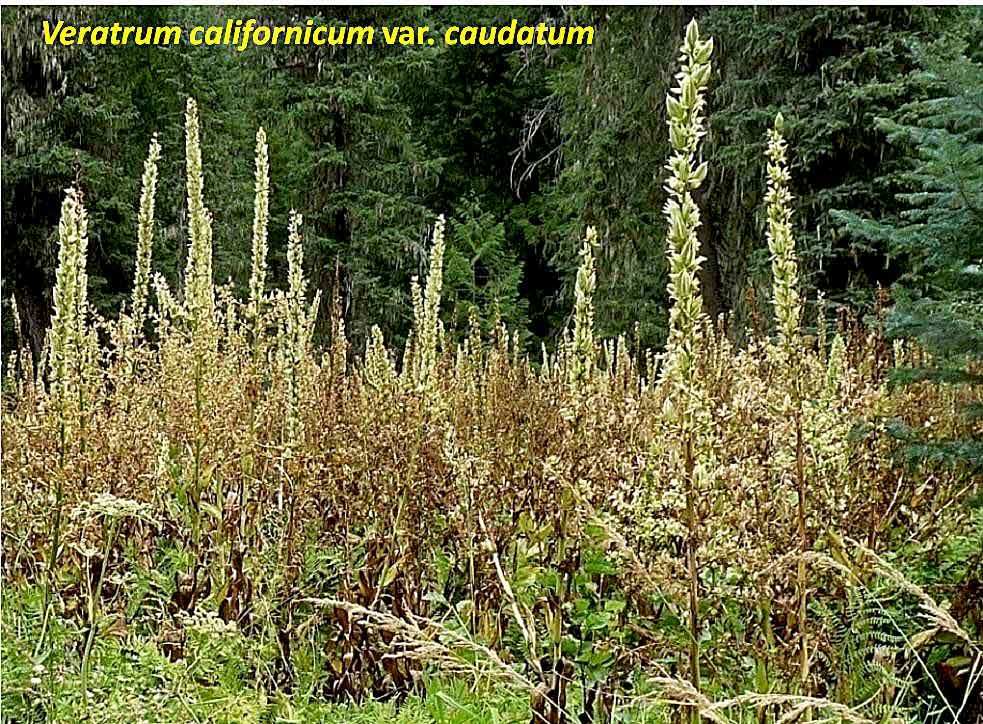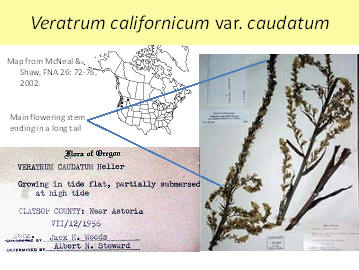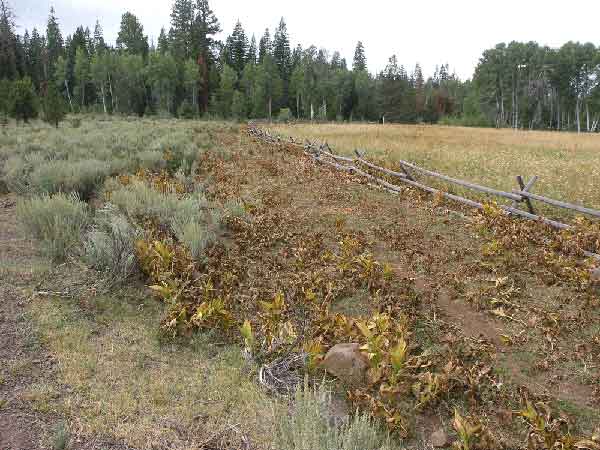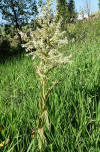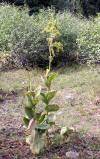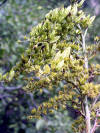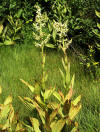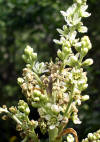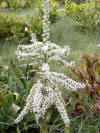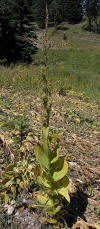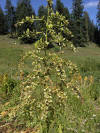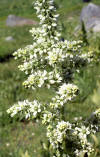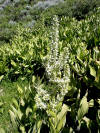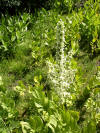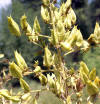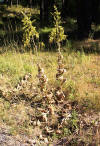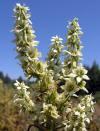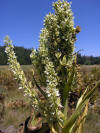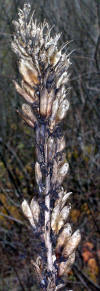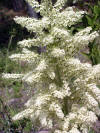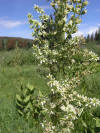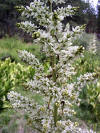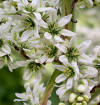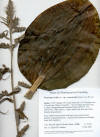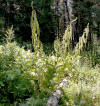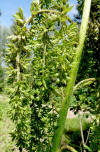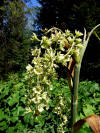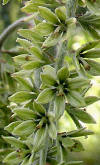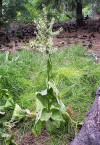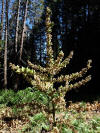|
Selected References:
American Cancer
Society. Chemotherapy and other drugs for pancreatic cancer..
http://www.cancer.org/cancer/pancreaticcancer/detailedguide/pancreatic-cancer-treating-chemotherapy
Accessed June 2016.
Anderson, V.
J. and R. M. Thompson. 1993. Chemical and mechanical control of false
Hellebore (Veratrum californicum) in an alpine community. U.S.
Dept. of Agriculture, Forest Service, Intermountain Research Station,
Research paper INT; 469.. Ogden, UT (324 25th St., Ogden 84401) . 6 p.
Anonymous.
1967. Veratrum alkaloids in the therapy of myasthenia gravis.
Can. Med. Assoc. J. 96(23): 1534–1535.
Bastin, 1895.
E. S. Structure of Veratrum viride. Amer. J. Pharm. 67 (4):
1–8. Botanical Medicine Monographs and Sundry. The Southwest School
of Botanical Medicine http://www.swsbm.com.
This is about the morphological structure of the root-rhizome.
Berman, D. M.,
S. S., Karhadkar, A. R. Hallahan, J. l. Pritchard, C. G.
Eberhart, D. N. Watkins, J. K. Chen, M. K. Cooper, J. Taipale, J. M.
Olson, and P.A. Beachy. 2002. “Medulloblastoma growth
inhibition by Hedgehog Pathway Blockade. Science 297:
1559–1561. “Constitutive Hedgehog (Hh) pathway activity is
associated with initiation of neoplasia, but its role in the continued
growth of established tumors is unclear. Here, we investigate the
therapeutic efficacy of the Hh pathway antagonist cyclopamine in
preclinical models of medulloblastoma, the most common malignant brain
tumor in children. Cyclopamine treatment of murine medulloblastoma cells
blocked proliferation in vitro and induced changes in gene expression
consistent with initiation of neuronal differentiation and loss of
neuronal stem cell-like character. This compound also caused regression of
murine tumor allografts in vivo and induced rapid death of cells from
freshly resected human medulloblastomas, but not from other brain tumors,
thus establishing a specific role for Hh pathway activity in
medulloblastoma growth.”
Binns W., L. F.
James, R. F. Keeler and L. D. Balls. 1968. Effects of
teratogenic agents in range plants.
Cancer
Res. 28(11): 2323–3236.
Cazares, E., J. M.
Trappe, & A. Jumpponen. 2005. Mycorrhiza-plant colonization patterns on
a subalpine glacier forefront as a model system of primary succession.
Mycorrhiza 15: 405–416. Lyman glacier in the North Cascades
Mountains of Washington has a subalpine forefront characterized by a
well-developed terminal moraine, inconspicuous successional moraines,
fluting, and outwash. These deposits were depleted of symbiotic fungi
when first exposed but colonized by them over time after exposure. Four
major groups of plant species in this system are (1) mycorrhiza
independent or facultative mycotrophic, (2) dependent on arbuscular
mycorrhizae (AM) (3) dependent on ericoid mycorrhiza (ERM) or
ectomycorrhizae (EM), and (4) colonized by dark -septate (DS) endophytes.
We hypothesized that availability of mycorrhizal propagules was related
to the success of mycorrhiza-dependent plants in colonizing new
substrates in naturally evolved ecosystems. To test this hypothesis
roots samples of 66 plant species were examined for mycorrhizal
colonization. The plants were sampled from communities at increasing
distances from the glacier terminus to compare the newest communities
with successively older ones. Long established, secondary successional
dry meadow communities adjacent to the glacier forefront, and nearby
high alpine communities were sampled for comparison. DS were common on
most plant species on the forefront. Nonmycorrhizal plants predominated
in the earlier successional sites, whereas the proportion of mycorrhizal
plants generally increased with age of community. AM were present,
mostly at low levels, and nearly absent in two sites of the forefront.
ERM were present in all species of Ericaceae sampled, and EM in all
species of Pinaceae and Salicaceae. Roots of plants in the long
established meadow and heath communities adjacent.to the forefront and
the high alpine community all had one or another of the colonization
types, with DS and AM predominating.
Cholakova M.,
V. Christov, N. Kostova, R. Todorova, E. Georgieva and E. Nikolova.
2005. Biological activity of Veratrum alkaloids. Exp.
Pathol. Parasitol. 8(2): 16–19. “The biological
activity and the chemical classification of alkaloids isolated from
Veratrum plants are discussed.” The article mentions that
cyclopamine has been isolated from several species.
Consortium of
California Herbaria CAS-DS · CDA · CHSC · DAV · HSC · IRVC · OBI · PGM ·
RSA-POM · SBBG · SD · SDSU · SJSU · UC-JEPS · UCR · UCSB · UCSC. 270
records for Veratrum californicum, 12 records for V. viride.
Feb 2010.
Consortium of
Pacific Northwest Herbaria. Managed by the University of Washington
Herbarium, Burke Museum of Natural History and Culture, Box 355325
University of Washington, Seattle, WA 98195. 129 records for
Veratrum californicum, 215 records for V. viride. Feb 2010.
Contois, M.,
J. Cahill, N. Chavez, C. Cacace, G.I. Wechsler, M. Pauli and E.
Kosman. 2004. Estimating Corn Lily
Abundance in Bear Trap Meadow, July 2004. http://userwww.sfsu.edu/~efc/classes/biol315/cornlily.pdf
Cosgriff, R.,
V. J. Anderson, and S. Monsen. 2004. Restoration of communities
dominated by false hellebore. J. Range Mgmt. 57:365–370. “False hellebore (Veratrum californicum Durand) is a
native component of high-elevation, meadow-riparian areas of the mountain
West that has increased due to historic heavy grazing. In 1991, a study
was established in dense stands of false hellebore to evaluate mechanical
and chemical control methods to reduce false hellebore and increase the
abundance of the other native herbaceous species in these tall-forb
communities. Four control methods consisting of the herbicide glyphosate
(N-phenophonomethylglycine), mow, mowing in 2 consecutive years (remow),
and tillage were used in 1991-1992. Each method was evaluated based on (1)
reduction of false hellebore stem densities; (2) response of residual
understory species; and (3) effectiveness of seeding a perennial grass and
forb mixture to sustain initial treatment control. Stem density of false
hellebore and nested frequency data for all species were collected in
1991, 1992, 1995, and 1999. The glyphosate treatment was effective in
reducing false hellebore stem density which allowed for recovery of the
remnant tall-forb community. The till treatment, while effectively
reducing false hellebore stem density, also eliminated the other species
in the community, leaving it open to invasive weeds. The mow and remow
treatments did not reduce false hellebore stem density, but did allow for
recovery of other components of the tall-forb community. Seeding following
control treatments had no effect on false hellebore stem densities due to
poor establishment. The mechanical treatments were generally more
cumbersome in application and limited to gentle topography and
well-drained sites without surface rocks. The application of herbicides is
much easier and is adaptable to all types of terrain. The use of the
herbicide glyphosate gave the best balance of false hellebore control and
recovery of the tall-forb community.”
CPAM (Confirmed
Plant and Animal Materials). 1977. T–Z. (p. 582).
Cseri J., M.
Dankó, L. Kovács, G. Szücs and E. Varga. 1980. Analysis of the sensitizing
effect of veratrum alkaloids to potassium on frog muscle. Acta
Physiol. Acad. Sci. Hung. 56(3): 289–301. “The sensitizing
effect of veratrum alkaloids to potassium is not specific. Reducing the
concentration of chloride in Ringer's solution, or treating the muscle
with nicotine in a concentration close to threshold after pretreatment
with subliminal concentration of cevadine result in a marked mechanical
response of the muscle. However, cevadine does not alter the sensitivity
of the muscle to caffeine. On the basis of these observations it has been
suggested that veratrum alkaloids sensitize the muscle membrane
essentially to depolarizing processes. 2. Cevadine, 0.01 mM, fails to
depolarize the muscle membrane but increases the depolarizing effect of 10
mM potassium. The depolarizing effect of a reduction of the concentration
of chloride from 120 mM to 30 mM is also increased in cevadine pretreated
muscle. Cevadine pretreatment increases the depolarizing effect of
nicotine, too. 3. The above sensitizing effects are unanimously
Na-dependent. Accordingly there is no mechanical response and increased
depolarization in muscles equilibrated in sodium-free (choline) Ringer's
solution before the cevadine treatment. 4. On the basis of the present
data it is suggested that the membrane, when sensitized by veratrum
alkaloids, can be triggered by different depolarizing processes and the
depolarization increases as the result of increased Na permeability. The
increased depolarization at the threshold level becomes sufficient for the
automatic regenerative processes of the action potential to develop which
activate the contractile elements. However, the mechanical response is a
prolonged contraction rather than a contracture, its long period being the
result of a very slow repolarization caused by the well-known inhibitory
effect of veratrum alkaloids on Na inactivation.”
DeVelice, R.
L. 2003. In search
of a cure. Sour Dough Notes: 23, Editor's Note.
Fluck H. and
H. R. Hegi. 1956. [Studies on the alkaloids of the surface organs of Veratrum album L. I. Qualitative studies on the alkaloids of the
leaves.] Pharm. Acta Helv. 31(9): 428–447. German.
Fluck H. and
H. R. Hegi. 1960. [Studies on the alkaloids in the aerial organs of Veratrum album L. Part 3. Fluctuations in the alkaloid content of
the aerial organs, especially the low-lying leaves, of Veratrum album L.] Pharm. Acta Helv. 35: 1–12.
Fuska J., A. Fusková,
A. Vassová and Z. Votický. 1981. New substances with cytotoxic and
antitumor effects. IV. In vitro effect of some veratrum alkaloids and
their derivatives on leukemia P388 cells. Neoplasma 28(6): 709–714. “Some
Veratrum alkaloids and their derivatives exhibited an in vitro
cytotoxic effect on leukemia P388 cells, depending on the structure of the
skeleton of the molecule, particularly on the type of the heterocycle
attached to C-20. Veracintine and
20-(2-methyl-1-pyrrolin-5-yl)-4-pregnen-3-one, which proved to be the most
effective, inhibited incorporation of uridine, and to a lesser extent that
of L-valine into P388 cells fractions. After a brief reaction (15 min),
these substances became irreversibly bound in the P388 cells and stopped
their further in vitro proliferation. The cytotoxic effect of veracintine
became enhanced by sublethal doses of tubercidine (phase of maximum
lethality of G1).
Heretsch, P., L.
Tzagkaroulaki, and Athanassios Giannis. 2010. Cyclopamine and Hedgehog
Signaling: Chemistry, Biology, Medical Perspectives. Angew. Chem. Int.
Ed. 49: 2–12 (online preprint). "When Odysseus left the
devastated city of Troy after ten years of siege he could not foresee
the perils he still had to face. The encounter with the cyclops, a giant
with only one eye placed in the middle of its forehead, was doubtlessly
one of the creepiest and most dangerous of his adventures. In the end,
Odysseus could only escape with the help of a sheep. Whether Homers
cyclops was inspired by the observation of terribly malformed neonates
remains speculative. However, when sheep herders in Idaho in the middle
of the 20th century faced an increasing number of cyclops-like sheep in
their herds, a unique cascade of chemical, biological, and
medicinal discoveries was initiated. This Minireview tells this story
and shows its impact on modern biomedical research."
Incardona, J.
P. W. Gaffield, R. P. Kapur and H. Roelink. 1998. The
teratogenic Veratrum alkaloid cyclopamine inhibits sonic hedgehog signal
transduction. Development 125: 3553–3562. “The
steroidal alkaloid cyclopamine produces cyclopia and holoprosencephaly
when administered to gastrulation-stage amniote embryos.
Cyclopamine-induced malformations in chick embryos are associated with
interruption of Sonic hedgehog (Shh)-mediated dorsoventral patterning of
the neural tube and somites. Cell types normally induced in the ventral
neural tube by Shh are either absent or appear aberrantly at the ventral
midline after cyclopamine treatment, while dorsal cell types normally
repressed by Shh appear ventrally. Somites in cyclopamine-treated embryos
show Pax7 expression throughout, indicating failure of sclerotome
induction. Cyclopamine at concentrations of 20-100 nM blocks the response
of neural plate explants to recombinant Shh-N in a dose-dependent manner.
Similar concentrations have no effect on the post-translational
modification of Shh by cholesterol in transfected COS-1 cells. Comparison
of the effects of cyclopamine to those of the holoprosencephaly-inducing
cholesterol synthesis inhibitor AY-9944 shows that cyclopamine does not
induce malformations by interfering with cholesterol metabolism. Although
AY-9944 does not interrupt Shh signaling in ovo, it blocks the response to
Shh-N in explants cultured without an exogenous cholesterol source. As
predicted by current models of the regulation of cholesterol metabolism,
the response to Shh-N in AY-9944-treated explants is restored by providing
exogenous cholesterol. However, exogenous cholesterol does not restore Shh
signaling in cyclopamine-treated explants. These findings suggest that
cyclopamine-induced teratogenesis is due to a more direct antagonism of
Shh signal transduction. ”
Infinity
Pharmaceuticals, Inc (IPI). 2009. Infinity Announces Hedgehog
Pathway Preclinical Data in Ovarian Cancer Data Demonstrate Significant
Inhibition of Tumor Growth in Primary Ovarian Cancer. Globe NewsWire.
http://www.globenewswire.com/newsroom/news.html?d=159274.
James, L. F. 1999.
Teratological research of the USDA-ARS Poisonous Plant Research
Laboratory. J. Nat. Toxins 8: 63–80. “Research on teratogenic
plants started at the USDA-Agricultural research Service Poisonous Plant
Research Laboratory in the mid 1950's when Dr. Wayne Binns, Director of
the laboratory, was asked to investigate the cause of a cyclopain
facial/skeletal birth defect in lambs. Dr. Lynn F. James joined the
staff shortly after. These two people worked as a team wherein most
planning was done jointly with Binns supervising most of the laboratory
work and James the field studies. It was determined that when
pregnant ewes grazed Veratrum californicum on day 14 of gestation a
significant number of lambs had the cyclopic defect. Skeletal and
cleft palate birth defects in calves was associated with pregnant cows
grazing certain lupine species during 40–70 days of gestation.
Shortly thereafter research work was initiated on locoweed which caused
abortions, wasting, right heart failure, skeletal birth defects, and fetal
right heart failure. Dr. Richard F. Keeler, a chemist who joined the
staff in the early 1960's isolated and characterized the teratogens in
V. californicum as the steroidal alkaloids cyclopamine, jervine, and
cycloposine. He also described the terotogen in lupines as the
quinolizidine alkaloid angyrine and the piperidine alkaloid ammodendrine.
Drs. Russell Molyneux and James identified the toxin in locoweed as the
indolizidine alkaloid swainsonine.” “In 1974 the editor of Nutrition Today
(Vols. 9 and 4) wrote 'The idea that birth defects occurring in humans may
be in some way related to diet is not widely held...' Dr. Lynn James
pointed out in this issue that such defects in animals can be produced
with absolute predictability and regularity by foods ordinarily beneficial
to livestock. Management strategies have been developed to prevent
or minimize the economic impact of the cyclopian lamb and the crooked calf
condition on livestock producers and well on the way to doing the same
with locoweed. It is of interest to note that livestock researching
on Veratrum, lupines and locoweed and toxins therefrom are now
significant research tools for specific human health problems.”
Keeler, R. F. 1968.
Teratogenic compounds of Veratrum californicum (Durand). IV. First
isolation of veratramine and alkaloid Q and a reliable method for
isolation of cyclopamine. Phytochemistry 7: 303–306.
Keeler, R. F. 1969.
Toxic and teratogenic alkaloids of western range plants. J. Agric. Food
Chem. 17: 473–482.
Keeler, R. F., and
W. Binns. 1971. Teratogenic compounds of Veratrum californicum as a
function of plant part, stage, and site of growth. Phytochemistry,
10: 1765–1769. “The level of the teratogen cyclopamine in Veratrum
californicum varied considerably among plants from various collection
sites. The variation was not correlated with differences in soil type, pH,
soil nutrients, elevation, drainage, or sunlight. However, marked
variation in both total alkaloid and percentage cyclopamine occurred as a
function of stage of growth of the plant. The levels of both were highest
in early growing season in the leaves, in midgrowing season in the stems
and in late growing season in the root/rhizome system.”
Keeler, R. F. 1978.
Cyclopamine and related steroidal alkaloid teratogens: their occurrence,
structural relationship, and biologic effects. Lipids. 13(10):
708–715. “A spontaneous congenital deformity is produced in lambs
whose dams consume Veratrum californicum on the 14th day of
gestation. The deformity is generally expressed as cyclopia, cebocephaly,
anophthalmia, or microphthalmia. This teratogenic effect is produced by
certain steroidal alkaloid teratogens from the plant - most notably the
compound cyclopamine. Cyclopamine is a C-nor-D-homo steroid with fused
furanopiperidine rings E and F at right angles to the plane of the steroid
because of spiro attachment at C-17 of the steroid. Among veratrum
alkaloids, only those with an intact furan ring E were teratogenic in
sheep, whereas those in which the peperidine ring is not rigidly
positioned at right angles to the steroid were not. Many ruminants and
laboratory animals are susceptible to the teratogen. It has wide species
and tissue specificity and appears to have a direct effect on the embryo,
not as a consequence of metabolic alteration of its structure nor as an
indirect effect through a maternal influence. Other plant sources, notably
potatoes, tomatoes, and eggplant contain related spirosolane steroidal
alkaloids. Among naturally occurring spirosolanes, solasodine is
teratogenic in hamsters, but neither tomatidine not diosgenin, the
non-nitrogen containing analog of solasodine, is teratogenic. Results of
these and other studies suggest that a basic nitrogen positioned alpha
with respect to the steroidal plane and at appropriate distance beyond the
D ring confers the teratogenicity on the molecule. Potato sprouts with
high alkaloid content are teratogenic in hamsters, but tubers and peels
are not.”
Keeler, R. F. and W.
Binns 2005. Teratogenic compounds of Veratrum californicum
(Durand). V. Comparison of cyclopian effects of steroidal alkaloids from
the plant and structurally related compounds from other sources Teratology
1: 5–10. Cyclopamine, and its glycoside alkaloid X,
along with jervine and veratrosine, induced cyclopian malformations in
offspring born to ewes ingesting these compounds on the fourteenth day of
gestation. Other steroidal alkaloids with somewhat similar structures and
various other steroidal compounds including certain hormones and steroidal
sapogenins did not induce the malformation.”
Klohs,M.
W., M. D. Draper, F. Keller, S. Koster, W. Malesh and F. J. Petracek.
1953. The Alkaloids of Veratrum fimbriatum Gray. J. Am. Chem. Soc.;
75(20): 4925 - 4927. "A chemical investigation of
Veratrum fimbriatum Gray has yielded two new hypotensively active
germine esters, germanitrine (C39H6901lN), and germinitrine (C39H57011N),
as well as neogermitrine, jervine and pseudojervine. In addition, the
alkaloidal ester, veratroylzygadenine, previously isolated from
Zygadenus venenosus Wats was found to be present in this species of
Veratrum. On hydrolysis, the triester germanitrine affords germine,
acetic acid, tiglic acid and (I)-a-methylbutyric acid. The hydrolysis of
the triester germinitrine, yielded germine, acetic acid, tiglic acid and
angelic acid. On methanolysis, germanitrine readily loses a labile acetyl
group yielding germanidine."
Krayer O., S.
M. Kupchan, C. V. Deliwla and B. H. Rogers. 1953. Studies on Veratrum
alkaloids. XVIII. Chemical and pharmacological relations between
Zygadenus and Veratrum alkaloids. Naunyn Schmiedebergs Arch.
Exp. Pathol. Pharmakol. 219(5): 371–385.
Krupp H., L.
Lendle and K. Stapenhorst. 1952. [The use of nicotin and
veratrum alkaloids as insecticides.]. Arzneimittelforschung 2(6): 258-62.
Kupchan S. M.,
J. C. Grivas, C. I. Ayres, L. J. Pandya and L. C. Weaver.
1961. Veratrum alkaloids. XLVI. Structure-activity relationships in
a series of analogs of the protoveratrines. J. Pharm.
Sci. 50: 396–403.
Kupchan, S. M.
1961. Hypotensive Veratrum ester
alkaloids. J. Pharm. Sci. 50: 273–287.
Kupchan, S. M.
and R. H. Nehnsler. 1961. Veratrum alkaloids. XLIV. Structure-activity relationships in a series of synthetic hypotensive esters of protoverine. J. Med. Pharm. Chem. ;3:
129–155.
Kutney
J. P., J. Cable, W. A. Gladstone, H. W. Hanssen, E. J. Torupka and W. D.
Warnock. 1968. The total synthesis of Veratrum alkaloids. I.
Verarine. J. Am. Chem. Soc. 90 (19): 5332–5334.
Li, H-l., J.
Tang, R-h. Liu, M. Lin, B. Wang, Y-f. Lv, H-q. Huang, C. Zhang, and W-d.
Zhang. 2007. Characterization and identification of steroidal alkaloids in
the Chinese herb Veratrum nigrum L. by high-performance liquid
chromatography/electrospray ionization with multi-stage mass spectrometry.
Rapid Communications in Mass Spectrometry 21(6): 869–879.
Electrospray ionization multi-stage mass spectrometry (ESI-MSn)
was performed to study the fragmentation behaviour of seventeen steroidal
alkaloids (4 protoverine-type alkaloids, 10 germine-type alkaloids and 3
zygadenin-type alkaloids) from the Chinese herb Veratrum nigrum L.
The MSn spectra of the [M+H]+ ions for steroidal
alkaloids provided a wealth of structural information on the substituted
groups. In positive ion mode, the three types of alkaloids showed very
different characteristic ions: m/z 436 or 418 for protoverine-type
alkaloids; m/z 438, 420 or 402 for germine-type alkaloids; m/z
440 or 422 for zygadenin-type alkaloids. These fragments were used to
deduce their mass spectral fragmentation mechanisms. Furthermore, the
primary compounds in methanolic extracts of the herb of Veratrum nigrum
L. were investigated by using liquid chromatography (LC)/ESI-MSn.
As a result, 21 steroidal alkaloids (5 protoverine-type alkaloids, 14
germine-type alkaloids and 2 zygadenin-type alkaloids) were selectively
identified from 27 determined peaks. Eleven compounds were unambiguously
identified by comparing with standard compounds and ten compounds were
tentatively identified or deduced according to their MSn data.
Two of these compounds (xingangermine and deacetyl xinganveratrine) were
found to be novel steroidal alkaloids. In addition, the chemical
structures of two pairs of steroidal alkaloid isomers were deduced by
comparing their fragment ions. Given the important structural information
of known and unknown steroidal alkaloids in crude herbal extracts, this
study is useful for identifying these types of steroidal alkaloids in
crude materials rapidly and selectively.”
Li H-J., Y.
Jiang and P. Li. 2006. Chemistry, bioactivity and geographical diversity
of steroidal alkaloids from the Liliaceae family. Nat. Prod. Rep.
23: 735–752.
Liang G. Y.
and N. J. Sun. 1984. [Chemical studies on active principles of Veratrum
stenophyllum. III. Studies on the structure of beta 1-chaconine and
the partial structures of stenophylline C and stenophylline D]. Yao Xue
Xue Bao. 19(6): 431-436.
Liang G. Y. and N. J. Sun.
1984. [Chemical studies on active principles of Veratrum stenophyllum.
II. Studies on
the structure of a
new blood pressure lowering agents--stenophylline A]. Yao Xue Xue Bao.
19(3): 190-194.
Liang G.
Y. 1984. [Studies on the alkaloids of Veratrum genus]. Yao
Xue Xue Bao. 19(4): 309-20.
Liao W.-J.,
Y.-M. Yuan and D.-Y. Zhang. 2007. Biogeography and evolution of
flower color in Veratrum (Melanthiaceae) through inference of a
phylogeny based on multiple DNA markers Plant Systematics and
Evolution 267:177–190. “Veratrum (Melanthiaceae)
comprises ca. 27 species with highly variable morphology. This study aims
to construct the molecular phylogeny of this genus to infer its floral
evolution and historical biogeography, which have not been examined in
detail before. Maximum parsimony, maximum likelihood, and Bayesian
analyses were performed on the separate and combined ITS, trnL-F,
and atpB-rbcL sequences to reconstruct the phylogenetic tree
of the genus. All Veratrum taxa formed a monophyletic group, within
which two distinct clades were distinguished: species with white-to-green
perianth formed one highly supported clade, and the species with
black-purple perianth constituted another highly supported clade.
Phylogenetic inference on flower color evolution suggested that
white-to-green perianth was a plesiomorphic state and black-purple
perianth was apomorphic for Veratrum. When species distribution
areas were traced as a multi-state character, parsimonious optimization
inferred that Veratrum possibly originated in East Asia. Our study
confirmed previous phylogenetic and taxonomic suggestions on this genus
and provided a typical example of plant radiation across the Northern
Hemisphere.”
Ma R., A. Ritala, K.
M. Oksman-Caldentey and H. Rischer. 2006. Development of in vitro
techniques for the important medicinal plant Veratrum californicum.
Planta Med. 72(12): 1142–1148. “Veratrum californicum (Liliaceae)
is an important monocotyledonous medicinal plant which is the only source
of the anticancer compound cyclopamine. An in vitro culture system for
somatic embryogenesis and green plant regeneration of Veratrum
californicum was developed. Embryogenic calli were induced from mature
embryos on induction medium. Five basal media supplemented with different
growth regulators were evaluated for embryogenic callus induction,
modified MS medium with 4 mg/L picloram showing the best result for
embryogenic callus production. Fine suspension cell lines were established
by employing friable embryogenic calli as starting material and AA medium
and L2 medium as culture media. The suspension cell lines cultured in AA
medium with 4 mg/L NAA appeared to be fresh yellow and fast growing. The
suspension cells were cryopreserved successfully and recovered at a high
rate. Green plants were regenerated from embryogenic calli maintained on
solid medium with 73 % regeneration ability (green plants/100 calli) in
27-month-old culture. The in vitro plantlets contained the steroid
alkaloids cyclopamine and veratramine. This in vitro system will form the
basis for metabolic engineering of Veratrum cells in the context of
biotechnological production of pharmaceutically important secondary
metabolites. DMSO:dimethyl sulfoxide fw:fresh weight NAA:naphthaleneacetic
acid 2,4-D:2,4-dichlorophenoxyacetic acid
picloram:4-amino-3,5,6-trichloro-2-pyridinecarboxylic acid
dicamba:3,6-dichloro-2-methoxybenzoic acid.”
Maj J.
[Investigations on Veratrum lobelianum Bernh.; Veratrum
extracts.] 1955. Acta Pol. Pharm. 11(Suppl): 108-110. Polish.
Mann, D. 2010.
IPI-926: Potential of natural products for drug development:
Investigations into Veratrum californicum (cow cabbage) as a
source.
Society for Range Management: Symposium—Medicinal Uses of Veratrum.
Annual Meeting with Weed Science Society of America, Denver, CO, Feb 7–11
(30 minute oral presentation, no abstract). https://srm.conference-services.net/programme.asp?conferenceID=1756&action=prog_list&session=7612
McNeal, Jr., D. W.
and A. D. Shaw. 2002. Veratrum. In Flora North America 26,
Liliaceae: 72–76.
Meilman E.
Clinical studies on veratrum alkaloids. III. 1953. The effect of
protoveratrine on renal function in man. J. Clin. Invest. 32(1): 80–89.
Meilman E. and O.
Krayer. 1950. Clinical studies on veratrum alkaloids; the action of
protoveratrine and veratridine in hypertension. Circulation.
Feb;1(2):204-13.
Monsen, S. 2010.
Wildland harvesting - site identification, lifting processes, and
restoration measures. Society for Range Management: Symposium—Medicinal
Uses of Veratrum. Annual Meeting with Weed Science Society of
America, Denver, CO, Feb 7–11 (30 minute oral presentation, no abstract).
https://srm.conference-services.net/programme.asp?conferenceID=1756&action=prog_list&session=7612
Murray, M. P.
1997. High elevations meadows and grazing. Internatl. J.
Wilderness 3(4):24–27.Abstract: “High elevation grazing of cattle
and sheep is a legal activity in wilderness areas administered by the U.S.
Forest Service (USFS) and Bureau of Land Management (BLM) and occurs in
about one-third of the U.S. Wilderness System (USWS). General effects of
grazing on species composition and soil properties are described based on
reported findings for three extensive types of high elevation
meadows-grass, herbaceous, and moist sedge. The challenge for wilderness
managers is to keep grazing within limits that protect the naturalness of
meadow ecosystems. In general, where excessive grazing occurs, shifts in
species composition from preferred livestock forage to less desirable,
nonpalatable, and exotic species is observed. Soils of each meadow type
respond differently to grazing pressure, and careful management should
reflect these differences. Suggestions are offered for careful control of
livestock distribution, timing, and stock numbers in order to protect
naturalness of high elevation wilderness meadows.”
Murray, M. P.
2003. Tree encroachment on Klamath Mountains meadows. Fremontia 31:
13–18.
National
Institutes of Health, National Cancer Institute. 1966.
Screening data
from the Cancer
Chemotherapy
National Service Center Screening Laboratories.
Plants collected and extracted by the University of Arizona. P. 116 in
regard to test results for fresh samples of root and flower-fruit from
Veratrum californicum collected in Apache County, AZ, Aug 1961;
aqueous and alcohol extracts tested in CA, KB, LE, and SA.
Neuss,
N., A new alkaloid from Amianthium muscaetoxicum Gray. Journal of
the American Chemical Society, 1953. 75: p. 2772-2773.
Oatis Jr, J. E
, P. Brunsfeld , J. W Rushing, P. D. Moeller, D. W. Bearden, T. N
Gallien6 and G. Cooper IV. 2008 Isolation, purification, and full NMR
assignments of cyclopamine from Veratrum californicum. Chem. Centr. J. ,
2:12doi:10.1186/1752-153X-2-12.
““The
Hedgehog signaling pathway is essential for embryogenesis and for tissue
homeostasis in the adult. However, it may induce malignancies in a number
of tissues when constitutively activated, and it may also have a role in
other forms of normal and maladaptive growth. Cyclopamine, a naturally
occurring steroidal alkaloid, specifically inhibits the Hedgehog pathway
by binding directly to Smoothened, an important Hedgehog response element.
To use cyclopamine as a tool to explore and/or inhibit the Hedgehog
pathway in vivo, a substantial quantity is required, and as a practical
matter cyclopamine has been effectively unavailable for usage in animals
larger than mice. In this paper, we report a rapid and efficient
isolation and purification of large quantities of cyclopamine from the
roots and rhizomes of Veratrum californicum Dur. (the Corn Lily or Western
false hellebore). We also provide unambiguous assignments of the carbon
and proton resonances by using the multinuclear spectra and the spin
coupling networks. This method could meet a very real need within diverse
scientific communities by allowing cyclopamine to become more readily
available.”
Olney H. O.
1968. Growth substances from Veratrum tenuipetalum. Plant
Physiol 43(3):293-302. “Young leaves and buds of Veratrum tenuipetalum yielded non-indolic growth accelerators and inhibitors in the
acidic ether fraction. The titer of accelerators decreased while the
inhibitors increased as leaves matured. This was also true when comparing
extracts of immature and fruiting inflorescences. Indole 3-acetic acid was
at no time detected in leaf, bud, and inflorescence extracts but indole
3-acetyl-aspartic acid was readily recovered from all of these.The
alkaline ether fraction of leaf base meristems, buds, roots, and rhizomes
was rich in crystalline and amorphous alkaloids and phenolic acids.
Reducing the quantity of major substances through crystallization,
precipitation, and filtration permitted thin film chromatographic
separation of the minor alkaloids and phenolic acids in the presence of
the major ones. The unchromatographed mixture, and also certain of the
purified major and minor alkaloids studied, strongly inhibited growth in
germinating oat and winter rye seeds. In addition, profound changes in
morphology and cytology of the seminal roots resulted. DNA disappeared
partially to completely from affected tissue in 2 day germinated seeds.”
Panter, K., K.
Welch, D. Gardner and S. Lee. 2010. False Hellebore (Veratrum
californicum): Historical perspectives and management implications for
livestock and wildlife.
Society for Range
Management: Symposium—Medicinal Uses of Veratrum. Annual Meeting
with Weed Science Society of America, Denver, CO, Feb 7–11 (30 minute oral
presentation, no abstract).
https://srm.conference-services.net/programme.asp?conferenceID=1756&action=prog_list&session=7612.
Potter. D. A. 1998.
Forested communities of the Upper Montane in the Central and Southern
Sierra Nevada. General Technical Report, PSW-GTR-169.
Qualtrough, D., P.
Rees, B. Speight, A. C. Williams and C. Paraskeva. 2015. The
hedgehog inhibitor cyclopamine reduces -Catenin-Tcf transcriptional
activity, induces E-Cadherin expression, and reduces invasion in
colorectal cancer cells. Cancers 2015, 7, 1885-1899;
doi:10.3390/cancers7030867. "Colorectal cancer is a major global
health problem resulting in over 600,000 deaths world-wide every year
with the majority of these due to metastatic disease. Wnt signalling,
and more specifically -catenin-related transcription, has been shown to
drive both tumorigenesis and the metastatic process in colorectal
neoplasia, yet its complex interactions with other key signalling
pathways, such as hedgehog, remain to be elucidated. We have previously
shown that the Hedgehog (HH) signalling pathway is active in cells from
colorectal tumours, and that inhibition of the pathway with cyclopamine
induces apoptosis. We now show that cyclopamine treatment reduces -catenin
related transcription in colorectal cancer cell lines, and that this
effect can be reversed by addition of Sonic Hedgehog protein. We also
show that cyclopamine concomitantly induces expression of the tumour
suppressor and prognostic indicator E-cadherin. Consistent with a role
for HH in regulating the invasive potential we show that cyclopamine
reduces the expression of transcription factors (Slug, Snail and Twist)
associated with the epithelial-mesenchymal transition and reduces the
invasiveness of colorectal cancer cells in vitro. Taken together, these
data show that pharmacological inhibition of the hedgehog pathway has
therapeutic potential in the treatment of colorectal cancer."
Ritala-nurmi, Anneli
(Helsinki, FI) Rischer, Heiko (Espoo, FI) Oksman-caldentey, Kirsi-marja
(Helsinki, FI) and Rui, Ma (Jilin, CN). 2009. Plant cell lines
established from the medicinal plant Veratrum californicum. US
Patent Application 20090305338, Filed 9/26/2007, published 12/10/2009.
http://www.freepatentsonline.com/y2009/0305338.html.
Ruskin, A. and
J. A., Rider. Veratrum viride, bio-assayed, in treatment of
essential hypertension. 1950. Tex. State J. Med. 46(2): 80-84.
Sawyer, J. O.,
T. Keeler-Wolf & J. M. Evens. 2008. A manual of California vegetation 2nd
ed. CNPS, Sacramento, CA.
Schaffner, U.
D. Kleijn, V. Brown and H. Müller-Schärer. 2001. Veratrum album in
montane grasslands: a model system for implementing biological control in
land management practices for high biodiversity habitats. BiocontrolNews
and Information 2001 22 (1): 19N – 28N.
Schep, L. J.;
D. M. Schmierer and J. S. Fountain. 2006. Veratrum Poisoning.
Toxicological Reviews. 25(2): 73-78. "Several species
of the Veratrum genus are associated with toxicity in humans and
animals. The principal toxins are steroid alkaloids; some have a modified
steroid template, whereas others differ in their esterified acid moieties.
These alkaloids act by increasing the permeability of the sodium channels
of nerve cells, causing them to fire continuously. Increased stimulation,
associated with the vagal nerve results in a reflex that causes the triad
of responses known as the Bezold-Jarisch reflex: hypotension, bradycardia
and apnoea. Clinically, various Veratrum extracts were marketed for
clinical use as antihypertensive drugs, but because of their narrow
therapeutic index were withdrawn from the market. Following the ingestion
of Veratrum alkaloids, expected signs and symptoms include vomiting
and abdominal pain, followed by cardiovascular effects such as bradycardia,
hypotension and cardiac conduction abnormalities and death. Similar
symptoms arise in other mammalian species ingesting these alkaloids;
teratogenic effects may occur to the fetuses of animals that have grazed
on Veratrum californicum. Treatment consists of supportive care,
with an emphasis on haemodynamic stability with fluid replacement,
atropine and vasopressors. The onset of symptoms occurs between 30 minutes
and 4 hours, and the duration of the illness can range from 1 to 10 days;
however, with prompt supportive care, patients typically make a full
recovery within 24 hours.”
Shakirov, R.,
V. V. Kul'kova and I. Nakhatov. 1994. Alkaloids of Veratrum lobelianum,
verdinine and 3,15-DI-O-(2-methylbutyroyl)germine. Khimiya
Prirodnykh Soedinenii 1: 100–104 [Chemistry of Natural Compounds 31(1):
79–85, 1995]. “The results are given of an
investigation of the alkaloid composition of the epigeal part of Veratrum
lobelianum Bernh. Veralomidine, rubijervine, germinaline, and the new
bases verdinine (1) and 3,15-di-O-(2-methylbutyroyl)germine (2) were
isolated. The structures of (1) and (2) have been established on the basis
of their physicochemical properties and transformations. This is the first
time that veralomidine has been isolated from a plant.
Society for Range
Management: Symposium—Medicinal Uses of Veratrum. Annual Meeting
with Weed Science Society of America, Denver, CO, Feb 7–11. “Veratrum
californicum has been recognized as a poisonous plant that can be
teratogenic in pregnant female sheep · The teratogenic agent has been
identified as the alkaloid cyclopamine · IPI-926, a derivative of
cyclopamine, is in clinical trials for cancer. Wildland harvesting
practices and techniques are being developed · Site restoration measures
are under investigation to generate a sustainable resource · The
environmental impact is a significant consideration in harvesting.
Chair: Steve Monsen.” https://srm.conference-services.net/programme.asp?conferenceID=1756&action=prog_list&session=7612
Spjut, R. W.
["Rich", "President's Message"] 2016.
The Search for the White
Corn Lily. Mimulus Memo, June: 5–7 [California Native Plant Society,
Kern Chapter].
Spjut, R. W.
2010. Potential harvest sites of Veratrum californicum in relation
to its taxonomy, geographical distribution, and presence of cyclopamine
and cycloposine. Society for Range Management: Symposium—Medicinal Uses of
Veratrum. Annual Meeting with Weed Science Society of America,
Denver, CO, Feb 7–11 (30 minute oral presentation, no abstract).
https://srm.conference-services.net/programme.asp?conferenceID=1756&action=prog_list&session=7612.
Richard Spjut has been conducting geographical surveys of corn lily for
the Infinity Pharmaceutical since Sep 2004, in Utah, Colorado, New Mexico,
Arizona, California, Nevada, Oregon, Idaho, and Wyoming.
Spjut, R. W. 1985.
Limitation of a Random Screen: Search for New Anticancer Drugs in Higher
Plants. Economic Botany 39(3): 266–288.
Tang J., H-L.
Li, Y-H. Shen, H-Z. Jin, S-K. Yan, R-H. Li, and W-D. Zhang. 2007.
Four New Germine Esters from Veratrum dahuricum. Helvetica Chimica
Acta 90(4): 769–775. “Four new alkaloids, compounds
1-4, based on the germine (=4,9-epoxycevane-3,4,7,14,15,16,20-heptol; 5)
framework, were isolated from the rhizomes of V. dahuricum, together with
germine proper. The X-ray crystal structure of germine (5) was solved, and
all compounds were characterized by circular dichroism, 1D- and 2D-NMR
(1H,1H-COSY, DEPT, HSQC, HMBC), as well as HR-MS analyses.”
Tang J., H-L.
Li, Y-H. Shen, H-Z. Jin, S-K. Yan, R-H. Li, and W-D. Zhang. 2007.
Antitumor activity of extracts and compounds from the rhizomes of
Veratrum dahuricum. Phytotherapy Res. 22: 1093–1096. “The
antitumor activity of six extracts (ethanol extract, petroleum ether
fraction, CHCl3 fraction, ethyl acetate fraction, n-butanol fraction and
total alkaloids) from the rhizomes of Veratrum dahuricum, and six
compounds (veratramine (1), jervine (2), germine (3), veramitaline (4),
veratrosine (5) and cyclopamine (6)) from the ethanol extract were
investigated in vitro. The 12 samples exhibited cytotoxic activity against
human tumor cell lines A549, PANC-1, SW1990 and NCI-H249. Among these
samples, CHCl3 fraction, the total alkaloids, compounds 1 and 6 showed
higher inhibitory activity, compound 3 selectively exhibited significant
cytotoxicity to SW1990 and NCI-H249.”
Taylor, C. A.
1956a. Alkaloid yields of Veratrum fimbriatum as influenced by
site, season and other factors. Econ. Bot. 10: 166–173.
"Alkaloid content of Veratrum fimbriatum is much greater during
rapid growth in early spring than the rest of the year. Top growth
at the expense of stored food reserves did not deplete alkaloids,.
Individual plants were in two categories regarding high or low percentage
alkaloid producers."
Taylor, C. A. 1956b.
The culture of false hellebore. Econ. Bot. 10: 155–165. “Veratrum
plants and seeds have winter formancy which is relieved by cold. The
germination behavior, storage life of seeds, requirements for nursery
culture and possibilities of vegetation propagation are described in this
article—also the habits of several species in the wild.”
USDA ARS Record of Plant
Procurement for Veratrum californicum from California
USDA ARS Record of
Plant Procurement for Veratrum californicum from Colorado
USDA Forest Service. Jarbidge Ranger District Rangeland Management
Project. FEIS Environmental Impact Statement (Humboldt-Toiyabe National
Forest). http://a123.g.akamai.net/7/123/11558/abc123/forestservic.download.akamai.com/11558/www/nepa/2865_FSPLT2_030279.pdf.
Incomplete. Not dated, but includes references published in 2008.
Wilkins R. W.,
J. R. Stanton and E. D. Freis. 1949. Essential hypertension; therapeutic
trial of veriloid, a new extract of Veratrum viride. Proc. Soc.
Exp. Biol. Med. 72(2): 302–304.
Wolters B.
1970. [Antimicrobial activity of Veratrum alkaloids]. Planta Med.
19(2): 189–196.
Yasuhiro, T.,
T. Kukuchi, W. Zhao, J. Chen and Y. Guo. 1998. (+)-Verussurine, a New
Steroidal Alkaloid from the Roots and Rhizomes of Veratrum nigrum
var. ussuriense and Structure Revision of (+)-Verabenzoamine1. J.
Nat. Prod. 61 (11): 1397–1399. “Two minor steroidal
alkaloids, 1 and 2, have been isolated from the roots and
rhizomes of Veratrum nigrum var. ussuriense. Their
structures have been determined by the use of spectral data as 7-O-acetyl-15-O-(2-methylbutyroyl)-3-O-veratroylgermine
(1) and 15-O-(2-methylbutyroyl)-3-O-veratroylgermine
(2). By spectral data comparison with verabenzoamine, the structure
of the latter compound has been revised from the previously reported 7-O-acetyl-15-O-(2-methylbutyroyl)-3-O-veratroylgermine
(1) to 15-O-(2-methylbutyroyl)-3-O-veratroylgermine (2).
Accordingly, alkaloid 1 [7-O-acetyl-15-O-(2-methylbutyroyl)-3-O-veratroylgermine]
must be new, and it was given the trivial name verussurine.”
Yagi, A. and
T. Kawasaki. 1962. [Alkaloids of Japanese Veratrum genus plants. V.
Alkaloids of Veratrum stamineum.] J. Pharmacol. 82: 210–213.
Youngken H. W.
1953. Studies on Veratrum. II. Veratrum eschscholtzii A.
Gray; observations on seed germination and early growth of seedlings of
Veratrum species. J. Am. Pharm. Assoc. Am. Pharm. Assoc. (Baltim.)
42(1): 39-45.
Youngken H. W.
1952. A pharmacognostical study of roots of different species of
Veratrum. J. Am. Pharm. Assoc. 41(7): 356-361.
Zhao W., Y.
Guo, S. Wang, T. Shao, Y. Tezuka and T. Kikuchi. 1998. [Chemical
research on stilbenes from Veratrum macckii Reg.]. Zhongguo Zhong
Yao Za Zhi. 23(10): 619–620, 640.“OBJECTIVE: To study the
components in rhizome of Veratrum macckii. METHODS: Column
chromatography and preparative thin layer chromatography with silica gel
were employed for the isolation and purification of constituents. The
structures were elucidated by IR, MS and 1H-NMR analysis. RESULTS: Two
compounds were obtained and elucidated as resveratrol and
2,3',4,5'-tetrahydroxystilbene. CONCLUSION: The two compounds were
separated from V. macckii for the first time.”
Zhao, W., W.
Hao, Y. Tezuka, T. Kikiuchi, J. Chen and Y. Guo. 1991. Studies
on the Constituents of Veratrum Plants. II. Constituents of
Veratrum nigrum L. var. ussuriense. (1). Structure and
1H-and 13C-Nuclear
Magnetic Resonance Spectra of a New Alkaloid, Verussurinine, and Related
Alkaloids. Chem. & Pharm. Bull. (Pharm. Soc. Japan): 39(3): 549–554.
“Alkaloidal constituents of the roots and rhizoma of Veratrum nigrum
L. var. ussuriense (Liliaceae), which are used as a source of the
Chinese crude drug "Li-lu, " were examined and a new alkaloid named
verussurinine and six known alkaloids have been isolated. The structure of
verussurinine was determined to be 16-O-(2-methylbutyroyl)germine (1) by
means of spectroscopic methods, and six other alkaloids were identified as
germidine (2), germerine (3), 15-O-(2-methylbutyroyl)germine (4), verazine
(5), jervine (6), and neogermbudine (7), Complete assignments of the
proton and carbon-13 nuclear magnetic resonance (^1H- and ^<13>C-NMR)
signals of these alkaloids are also presented.
Zhou C-X.,
J-Y. Liu, W-C. Yeb, C-H Liu and R-X. Tan. 2006. Neoverataline A and B, two
antifungal alkaloids with a novel carbon skeleton from Veratrum
taliense. Tetrahedron 59(30): 5743–5747. “Bioassay-guided
fractionation of the ethanol extract of the roots and rhizomes of
Veratrum taliense yielded two new and thirteen known steroidal
alkaloids. The structures of the two new compounds, neoverataline A and B,
were established by extensive spectroscopic analyses to be
3,4-secocevane-4,9-olid-14,15,16,20-tetra-ol-3-oic acid and
3,4-secocevane-4,9-olid-7,14,15,16,20-penta-ol-3-oic acid, respectively,
and are a novel carbon skelton. All of the fifteen alkaloids were
subjected to in vitro antifungal assays, which showed that the
verazine- (veramitaline, stenophylline B, stenophylline B-3-O-β- -glucopyranoside,
veramiline-3-O-β- -glucopyranoside,
veramiline-3-O-β- -glucopyranoside)
and jerveratrum-type (jervine, jervine-3-O-β- -glucopyranoside)
and jerveratrum-type (jervine, jervine-3-O-β- -glucopyranoside)
alkaloids exhibited strong antifungal activities against the
phytopathogenic fungus Phytophthora capisis with MICs of 160, 120,
160, 80, 80 and 120 μg·L−1, respectively. Furthermore, the
verazine-type alkaloids stenophylline B, stenophylline B 3-O-β- -glucopyranoside)
alkaloids exhibited strong antifungal activities against the
phytopathogenic fungus Phytophthora capisis with MICs of 160, 120,
160, 80, 80 and 120 μg·L−1, respectively. Furthermore, the
verazine-type alkaloids stenophylline B, stenophylline B 3-O-β- -glucopyranoside
and veramiline 3-O-β- -glucopyranoside
and veramiline 3-O-β- -glucopyranoside
were shown to also inhibit the growth of another fungal phytopathogen
Rhizoctonia cerealis with MICs of 160, 120 and 120 μg mL−1.
The MICs of triadimefon (an antifungal agrochemical used herein as a
positive control) against P. capisis and R. cerealis were
120 and 80 μg mL−1, respectively. A preliminary
structure–activity relationship regarding these alkaloids has been
formulated. ” -glucopyranoside
were shown to also inhibit the growth of another fungal phytopathogen
Rhizoctonia cerealis with MICs of 160, 120 and 120 μg mL−1.
The MICs of triadimefon (an antifungal agrochemical used herein as a
positive control) against P. capisis and R. cerealis were
120 and 80 μg mL−1, respectively. A preliminary
structure–activity relationship regarding these alkaloids has been
formulated. ”
Zhou C. X., J.
Tanaka, C. H. Cheng, T. Higa and R. X. Tan. 1999. Steroidal
Alkaloids and Stilbenoids from Veratrum taliense. Planta Med.
65(5): 480–482. “Phytochemical investigation of roots and
rhizomes of Veratrum taliense yielded a new and six known steroidal
alkaloids as well as a new and one reported stilbene derivative. By a
combination of spectral methods (IR, MS, (1)H- and (13)C-NMR, COSY, HMQC,
HMBC, and NOESY), the structure of the new alkaloid was established as
15-angeloylgermine while the known ones were identified as
15-(2-methylbutyroyl)germine, jervine, 3-veratroylzygadenine, germine,
veramiline 3- O-(beta- D-glucopyranoside and stenophylline B-3- O-beta- D-glucopyranoside.
The new stilbenoid, named veraphenol, was determined to be
2-(3',5'-dihydroxyphenyl)-6-hydroxybenzofuran, and the known one was shown
to be resveratrol. The IN VITRO enzyme assay indicated that
3-veratroylzygadenine and resveratrol are inhibitors of xanthine oxidase.
The enzyme inhibitory action of resveratrol, the most active compound
found so far in V. TALIENSE, is dose-dependent with the IC (50) value at
30 microM (the IC (50) value of allopurinolused as a positive control in
the study is 10 microM).”
Zimmerman J.
H. 1958. A monograph of Veratrum. Ph.D. dissertation, University of
Wisconsin, Madison, Wisconsin, USA.
Zomlefer, W.
B, W. S. Judd, W. M. Whitten and N. H. Williams. 2006. A synopsis of
Melanthiaceae (Liliales) with focus on character evolution in tribe
Melanthieae. Aliso 22: 566–578.
Zomlefer, W. B., W.
M. Whitten, N. H. Williams and and W. S. Judd. 2003. An
Overview of Veratrum s.l. (Liliales: Melanthiaceae) and an
Infrageneric Phylogeny Based on ITS Sequence Data. Syst. Bot. 28: 250–269.
“A synopsis of
Veratrum, including commentary on species and character
evolution within the genus, is presented. The circumscription and
relationships of infrageneric taxa are evaluated using parsimony analyses
of ITS (nuclear ribosomal) DNA sequence data of 26 representative taxa.
Proposed new infrageneric circumscriptions, strongly supported by tree
statistics and topologies, are correlated with potential morphological
synapomorphies at the proper level of universality. Based on our analyses,
Veratrum is circumscribed broadly (including
Melanthium) and divided into two sections and two subsections
(most with novel circumscription). This modified infrageneric
classification involves reassignment of
Veratrum subgenus
Pseudoanticlea as subsection
Pseudoanticlea. Although interspecific relationships are not
highly resolved, the molecular data provide strong support for placing
several species previously of unknown affinities and also validate several
generalizations concerning character evolution within
Veratrum.”
Zomlefer,
W. B., N. H. Williams, M. Whitten and W. S. Judd. 2000.
Generic circumscription and relationships in the tribe Melanthieae (Liliales,
Melanthiaceae), with emphasis on Zigadenus: evidence from ITS and
trnL-F sequence data. Am. J. Bot. 88: 1657–1699. “The circumscription and
relationships of genera within the tribe Melanthieae (29 representative
taxa) were evaluated using parsimony analyses of ITS (nuclear ribosomal)
and trnL-F (plastid) DNA sequence data, alone and in combination. Proposed
new generic circumscriptions, strongly supported by the tree statistics
and topologies in all analyses, are correlated with potential
morphological synapomorphies at the proper level of universality. Based on
the molecular cladograms, Stenanthium is biphyletic, and the
traditional Zigadenus s.l. (sensu lato) is polyphyletic.
Amianthium and Schoenocaulon are distinct entities; the
Veratrum complex is conservatively treated as one large monophyletic
genus (including Melanthium). Although some generic relationships
are not highly resolved, the analyses provide strong support for
Zigadenus glaberrimus as sister to the rest of the tribe, and
Amianthium muscitoxicum as closely related to Veratrum s.l. As
a result of these analyses, seven genera (some with novel circumscription)
are recognized within the tribe Melanthieae: Amianthium,
Anticlea, Schoenocaulon, Stenanthium, Toxicoscordion,
Veratrum, and Zigadenus.”
Zomlefer W. B. and K. D. Perkins 1999. Phylogeny of the Melanthiaceae.
Available at: http://www.flmnh.ufl.edu/natsci/herbarium/molecular/melan/
and http://ajbsupp.botany.org/v88/zomlefer/
Zomlefer W. B. 1997a The genera of Melanthiaceae in the southeastern
United States. Harvard Papers in Botany 2: 133-177. |
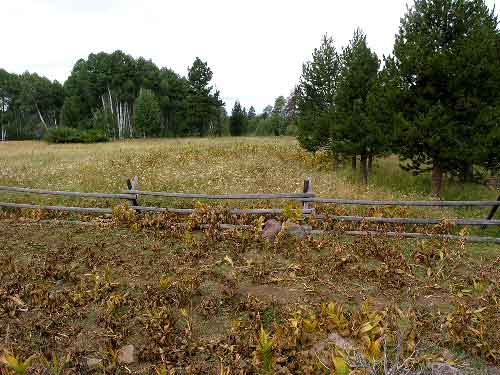
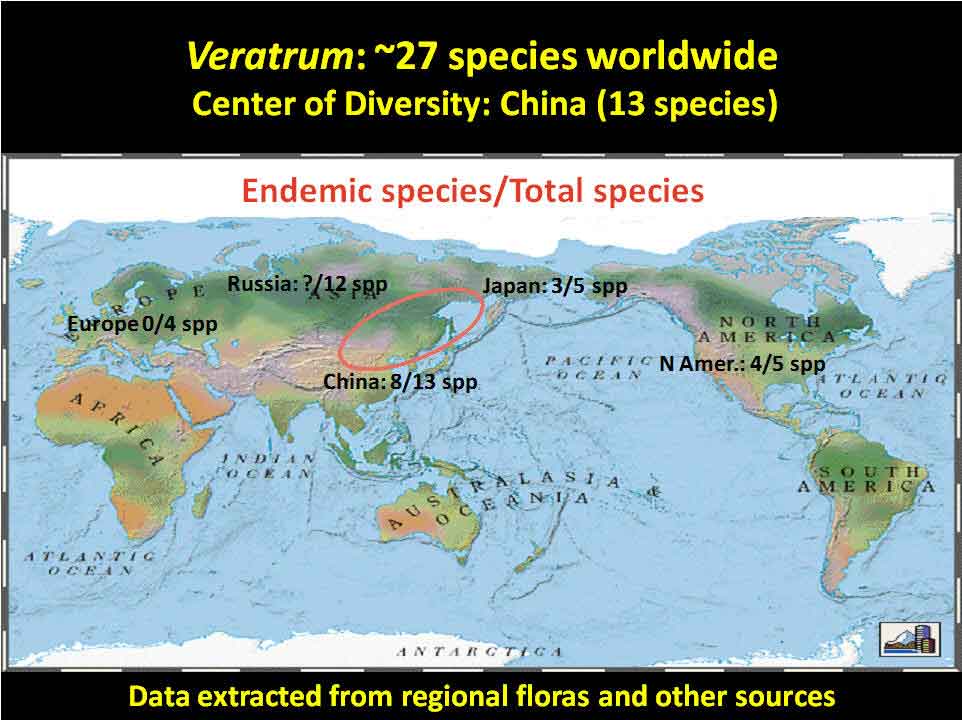
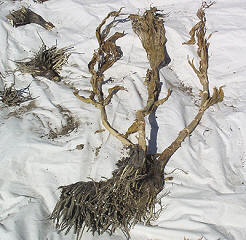
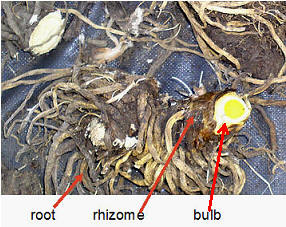
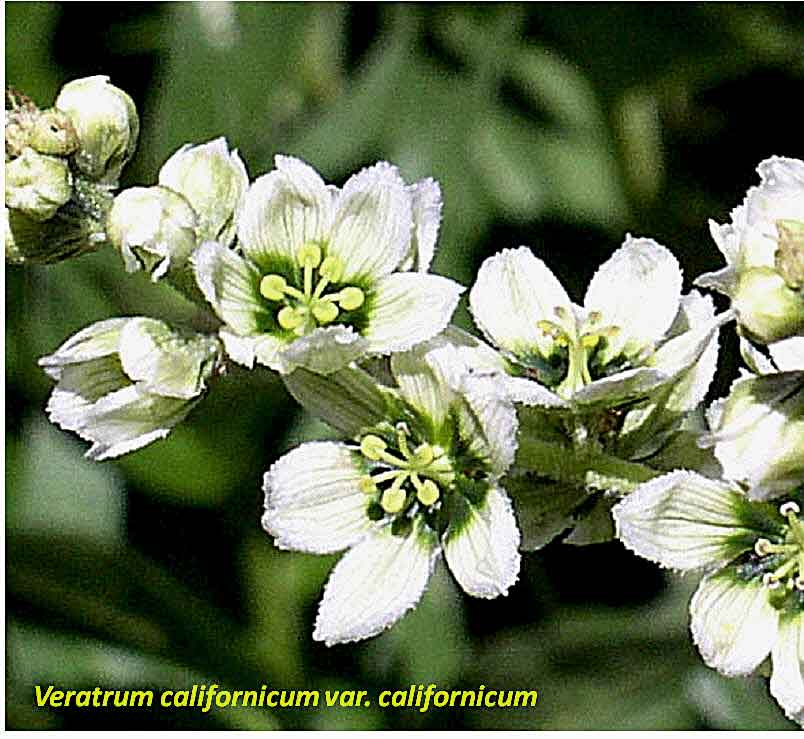
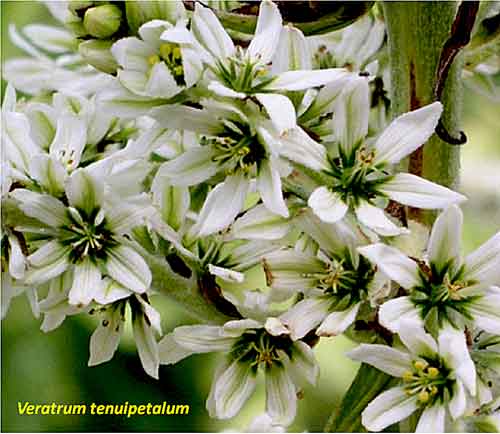
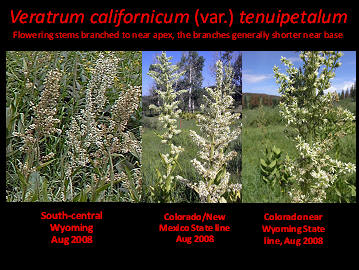 Many of the species may be further divided. For example,
within the Section Veratrum—recognized by the green V-shaped
nectar glands (Zomlefer et al. 2003)—are corn lily plants from
south-central Wyoming to Colorado-New Mexico state line that have been
distinguished as V. tenuipetalum A. Heller by the slightly smaller
(narrow elliptic) tepals (
Many of the species may be further divided. For example,
within the Section Veratrum—recognized by the green V-shaped
nectar glands (Zomlefer et al. 2003)—are corn lily plants from
south-central Wyoming to Colorado-New Mexico state line that have been
distinguished as V. tenuipetalum A. Heller by the slightly smaller
(narrow elliptic) tepals (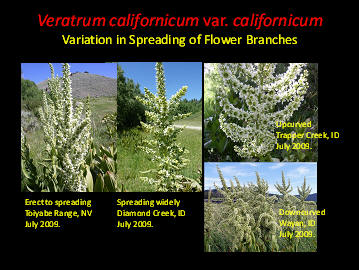 on
the tepals is difficult to evaluate due to their small size and subtle
variation in size,
especially as tepals develop and wither.
on
the tepals is difficult to evaluate due to their small size and subtle
variation in size,
especially as tepals develop and wither.
